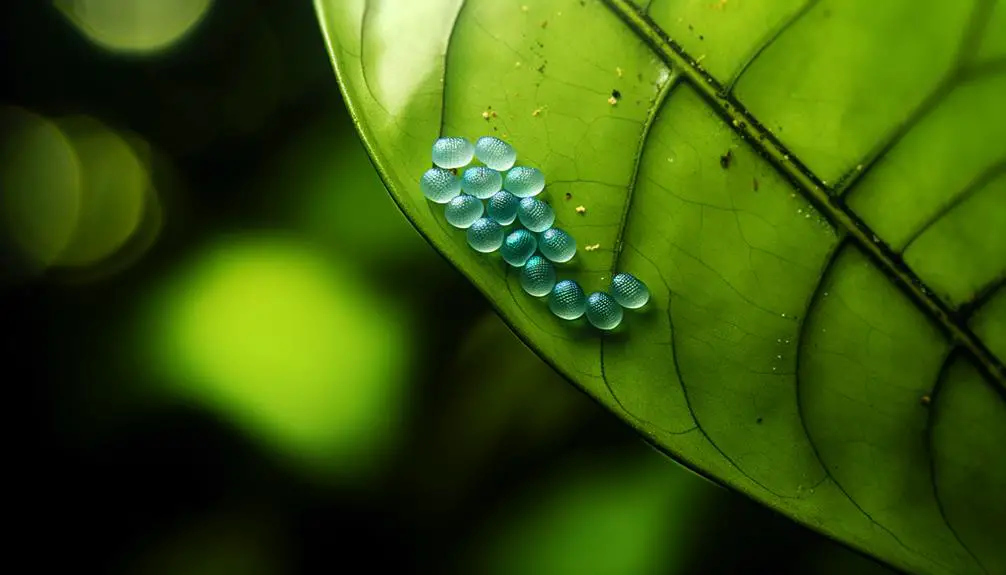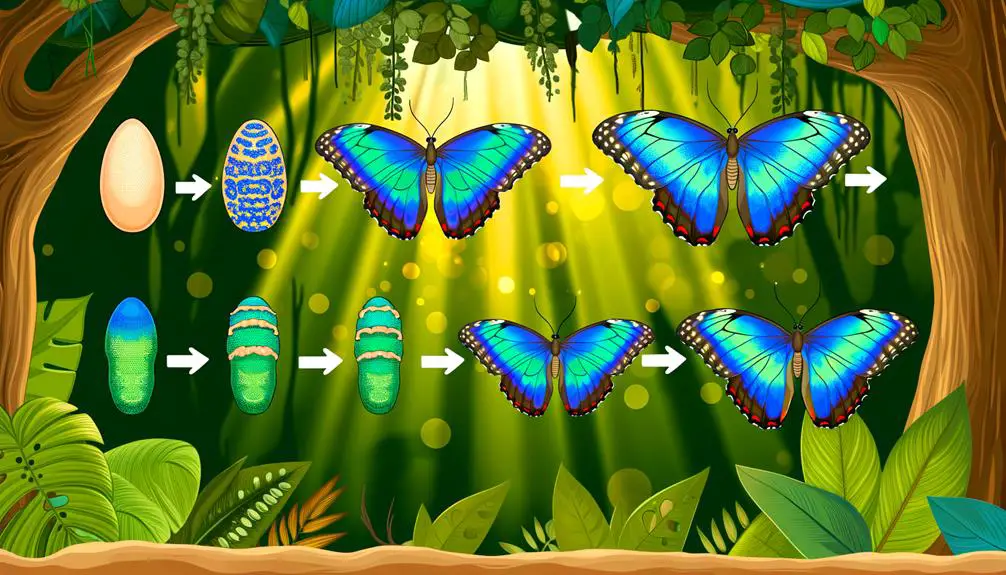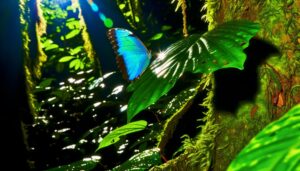Understanding the Life Cycle of a Blue Morpho Butterfly
The Blue Morpho Butterfly (Morpho peleides) undergoes a complex life cycle starting with the deposition of pale-green eggs on host plant leaves. After approximately 8 to 14 days, the eggs hatch into caterpillars that consume foliage voraciously, growing through multiple instars.
The caterpillars then form chrysalides, where metamorphosis occurs, transforming larval tissues into adult structures. Eclosion follows, marked by the emergence of a butterfly with striking blue wings that expands and hardens in hours.
Each stage is intricately tied to specific environmental conditions essential for survival and development, shedding light on the distinctiveness of its life cycle.

Key Takeaways
- Female Blue Morpho butterflies lay 20-50 pale-green eggs on host plant leaves.
- Eggs incubate for 8-14 days, influenced by temperature and humidity.
- Caterpillars hatch and feed on specific leguminous plants, growing rapidly through several molts.
- Caterpillars form a chrysalis for metamorphosis, transforming into adult butterflies.
Egg Stage

The egg stage of the Blue Morpho butterfly, Morpho peleides, begins when the female deposits her spherical, pale-green eggs on the underside of host plant leaves.
These host plants, primarily from the Fabaceae family, provide essential nutrients for the developing larvae. Each egg measures approximately 1.5 millimeters in diameter, ensuring ideal protection and nutrient provision.
The eggs exhibit a smooth, glossy surface, which minimizes water loss and deters predation. During this stage, embryogenesis occurs, driven by intricate cellular divisions and differentiation processes.
Environmental factors, including temperature and humidity, critically influence the embryonic development rate. This stage typically lasts between six to twelve days, contingent on external conditions, setting the foundation for subsequent larval emergence and growth.
Hatching
During the hatching phase, Blue Morpho butterfly eggs, meticulously laid by the female on host plants, enter an incubation period characterized by precise temperature and humidity requirements.
This stage culminates in the emergence of caterpillars, which marks the shift from embryonic development to larval life.
The synchronization of hatching with environmental conditions is essential for the survival and growth of the larvae.
Egg-Laying Process
Female Blue Morpho butterflies meticulously select the underside of leaves to deposit their eggs, ensuring ideal conditions for the hatching larvae. This strategic choice minimizes predation and environmental hazards.
The eggs, spherical and pale green, are laid singly or in small clusters, often on host plants like legumes, which provide essential nutrients for the emerging caterpillars. The chorion, or outer shell, is semi-permeable, allowing gas exchange while protecting the developing embryo.
Females exhibit remarkable precision, laying approximately 20 to 50 eggs over several days. Each egg measures about 1.5 mm in diameter, providing ample space for the initial stages of the larva.
This meticulous process underscores the species’ evolutionary adaptation for maximizing offspring survival in a competitive ecosystem.
Incubation Period
Incubation of Blue Morpho butterfly eggs typically spans 8 to 14 days, contingent upon ambient temperature and humidity levels. The ideal conditions for the incubation period are characterized by a fine balance, as deviations can greatly affect developmental timelines. During this phase, the embryonic development within the eggs progresses through vital stages, culminating in the formation of a fully developed larva ready to hatch.
Key factors influencing incubation include:
- Temperature: Higher temperatures accelerate metabolic rates, shortening the incubation period.
- Humidity: Adequate moisture levels prevent desiccation, ensuring successful embryonic development.
Understanding these variables is important for enhancing conditions that facilitate the successful hatching of Blue Morpho butterfly eggs.
Emergence of Caterpillars
Upon completion of the incubation period, the Blue Morpho butterfly eggs hatch, releasing tiny caterpillars that immediately begin their quest for nourishment.
These emerging larvae exhibit a voracious appetite, primarily consuming the foliage of host plants such as those from the Fabaceae family. The caterpillars possess specialized mandibles for efficient leaf consumption, ensuring rapid growth.
Initially, they exhibit cryptic coloration, blending seamlessly with their environment to avoid predation. As they progress through successive instars, they undergo significant morphological changes, including increased size and altered coloration patterns.
This stage is critical for accumulating energy reserves required for metamorphosis. The larvae’s feeding behavior and developmental shifts are meticulously timed to optimize survival and facilitate their progression to the pupal stage.
Caterpillar Growth

Upon hatching, the Blue Morpho butterfly shifts from egg to larva, initiating the caterpillar stage characterized by rapid growth and frequent molting.
Throughout this period, the caterpillar undergoes multiple instars, shedding its exoskeleton to accommodate its increasing size.
Its dietary preferences are primarily focused on specific host plants, essential for providing the necessary nutrients for development.
Egg to Larva
After the female Blue Morpho butterfly lays her eggs, the embryonic development within the egg progresses rapidly, leading to the emergence of the larva, commonly known as the caterpillar.
This stage is critical for the survival and growth of the Blue Morpho, as the caterpillar must efficiently consume nutrients to support its development. Upon hatching, the larva typically feeds on the eggshell before moving on to host plant leaves.
Key characteristics of the Blue Morpho caterpillar include:
- Coloration: Initially, the caterpillar exhibits a greenish hue, which later shifts to a distinctive brown with white markings.
- Feeding Behavior: The larva is voracious, consuming large quantities of foliage to fuel its rapid growth.
This detailed and precise examination of the ‘Egg to Larva’ progression underscores the complexity and efficiency of the Blue Morpho’s early life stages.
Molting and Growth
Molting, an essential process in the caterpillar growth phase, enables the Blue Morpho larva to shed its exoskeleton multiple times as it rapidly increases in size.
This physiological phenomenon, known as ecdysis, is driven by hormonal changes that facilitate the detachment of the old exoskeleton and the expansion of the new one.
Each molt, or instar, represents a distinct developmental stage, wherein the caterpillar’s body undergoes significant cellular and structural transformations.
The molting process is meticulously regulated to guarantee the larva can accommodate its escalating nutritional and metabolic demands.
Dietary Preferences
The Blue Morpho caterpillar mainly feeds on the leaves of specific leguminous plants, exhibiting a selective dietary preference that provides the necessary nutrients for its rapid growth and development.
This dietary selectivity guarantees ideal intake of essential amino acids and other vital nutrients, facilitating efficient protein synthesis and energy production. The caterpillar’s ability to thrive on these plants is a reflection of its evolutionary adaptation, guaranteeing successful metamorphosis.
Key aspects of its dietary preferences include:
- Nutrient-Rich Legumes: Mainly consumes leaves from plants like *Machaerium* and Pterocarpus species.
- Digestive Efficiency: Enhanced enzymes for breaking down plant defenses, maximizing nutrient absorption.
These dietary habits underscore the Blue Morpho caterpillar’s finely-tuned ecological niche.
Forming the Chrysalis
During the chrysalis formation, the caterpillar undergoes a remarkable transformation as it prepares to enter the pupal stage. The process begins with the larva finding a secure location, often on the underside of a leaf or branch, to attach itself.
Utilizing silk produced by its spinnerets, it creates a silk pad from which it hangs upside down in a characteristic ‘J’ shape. The outer skin then hardens and splits, revealing the chrysalis underneath.
This protective casing, known as the exoskeleton, shields the developing organism from environmental hazards. Internally, the caterpillar’s tissues break down into a nutrient-rich soup, a process known as histolysis, which sets the stage for the remarkable changes that will occur during metamorphosis.
Metamorphosis

Within the chrysalis, the blue morpho butterfly undergoes a profound and intricate process of metamorphosis, transforming from a caterpillar into a fully developed adult butterfly. During this time, the organism experiences significant cellular and structural reorganization.
Key processes include:
- Histolysis and Histogenesis: The caterpillar’s tissues break down (histolysis) and are reformed into adult structures (histogenesis).
- Imaginal Discs Development: Specialized groups of cells known as imaginal discs develop into the butterfly’s wings, legs, and antennae.
This metamorphic process epitomizes biological precision, orchestrating the complete transformation from a larval stage to a majestic butterfly.
Emerging as a Butterfly
Upon completing metamorphosis, the blue morpho butterfly initiates eclosion, emerging from its chrysalis with delicate, crumpled wings that soon expand and harden. This critical phase involves the rapid circulation of hemolymph within the wing veins, causing the wings to straighten and dry. The process typically spans several hours, ensuring structural integrity and readiness for flight.
| Life Stage | Key Characteristics |
|---|---|
| Chrysalis | Encasement, transformation |
| Eclosion | Emergence, wing expansion |
| Adult | Flight, reproduction |
During eclosion, the butterfly exhibits heightened vulnerability to predation and environmental hazards. Successful eclosion signifies the completion of its development, evolving into an adult capable of reproduction. The blue morpho’s vibrant wing coloration, attributed to microscopic scales reflecting light, serves as both a defense mechanism and a means of attracting mates. This striking iridescence not only deters predators by creating flashes of light but also plays a crucial role in courtship displays. Many people find deep symbolism in this transformation, leading them to explore the blue morpho butterfly tattoo meaning as a representation of change, resilience, and beauty. The butterfly’s journey from a vulnerable pupa to a dazzling adult serves as a powerful metaphor for personal growth and renewal.
Conclusion
The life cycle of the Blue Morpho butterfly, from egg to adult, presents a fascinating example of metamorphosis. Each stage—egg, hatching, caterpillar growth, chrysalis formation, and final emergence—demonstrates intricate biological processes.
The transformation, akin to alchemy, underscores the complexity and beauty of nature. Understanding these stages enhances knowledge of lepidopteran development and highlights the importance of conservation efforts.
Consequently, the Blue Morpho serves as a vivid reminder of the delicate balance within ecosystems.







If some one wishes to be updated with most up-to-date technologies then he must be pay a quick visit
this site and be up to date all the time.
Have a look at my web page :: Nordvpn coupons inspiresensation